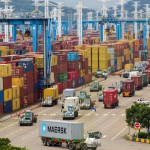Total number of posts 463.
Service reform and digitalization can create a positive cycle to increase economic opportunities and human empowerment, promoting development in the region
The World Bank (WB) sees positive bright spots in Southeast Asia in its latest economic growth forecast, saying the combination of service reform and digitalization is bringing new opportunities and improving the region's economy.

View in Manila, Philippines. Photo: AFP
In the World Bank's Economic Outlook for the Second Half of 2023 released on October 1, researchers forecast that developing economies in East Asia and the Pacific, including China and countries such as Cambodia, Indonesia, Malaysia, the Philippines, Thailand and Vietnam, will maintain strong growth of ̀% for the whole of 2023 but will ease in the second half of the year and reach 4.5% in 2024.
The World Bank's East Asia and Pacific Economic Update in October 10 states that the region's growth this year is higher than the average growth expected for all other developing and emerging market economies, but lower than the forecast outlined in the previous report.
Growth in China in 2023 is projected to be 5.1% and in the region excluding China is 4.6%. Growth in Pacific island nations is expected to be 5.2%. The World Bank forecasts that, in 2024, growth in China will slow to 4.4%. Growth in the rest of the region is expected to be 4.7% in 2024 as a global growth recovery and easing financial conditions will offset the impact of slowing growth in China and trade policy measures in other countries.
World Bank East Asia and Pacific Vice President Manuela V. Ferro said: "East Asia and the Pacific remains one of the fastest growing and most dynamic regions in the world, even if growth rates are moderate. In the medium term, to sustain high growth, reforms are needed to maintain industrial competitiveness, diversify trading partners, and unleash the productivity and employment-enhancing potential of the service sector."
A particular focus of the World Bank report noted that service sectors could play an increasing role in driving development in a region where manufacturing growth is based. The service sector has become a major contributor to aggregate labor productivity growth over the past decade. Exports of services grew faster than exports of goods. And the growth rate of foreign direct investment in the service sector has exceeded 5 times the growth rate of foreign direct investment in the manufacturing sector in China, Indonesia, Malaysia, the Philippines and Thailand.
Digital technologies and service reforms are improving economic performance in Southeast Asia, according to the World Bank. In the Philippines, the adoption of software and data analytics helped businesses increase productivity by an average of 1.5% between 2010 and 2019.
The World Bank pointed out that in Vietnam, reducing policy barriers such as restricting foreign individuals and enterprises from participating in or owning transport, financial and business services caused the value added per worker in these sectors to increase by 2.9% annually between 2008 and 2016. The removal of these barriers also increased labor productivity in manufacturing enterprises using these services by 3.1%, bringing significant benefits to small and medium-sized private enterprises.
The World Bank also pointed out that the combination of service reform and digitalization not only creates new opportunities but also enhances the capacity of people to take advantage of these opportunities. For example, distance education and telemedicine with support from well-trained, motivated local staff have led to better learning outcomes and health in the region.
World Bank Chief East Asia and Pacific Economist Aaditya Mattoo said: "Service reform and digitalization can create a positive cycle to increase economic opportunities and human empowerment, boosting development in the region."














